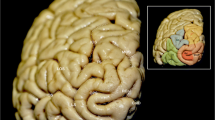Abstract
Purpose
In a previous cadaveric work, we identified and described useful and reproducible surface skin landmarks to lateral sulcus, central sulcus and preoccipital notch. Potential limitations of this cadaveric study have been raised. Thus, the objective of this study was to confirm radiologically the accuracy of these previously described surface skin landmarks on brain magnetic resonance imaging (MRI) of healthy subjects.
Methods
Healthy adult volunteers underwent a high-resolution brain MRI and measurements of the orthogonal skin projection (OSP) of the anterior sylvian point (AsyP), the superior Rolandic point (SroP) and the parietooccipital sulcus were made from nasion, zygomatic bone and inion, respectively. These measures were compared to our previous cadaveric findings.
Results
Thirty-one healthy volunteers were included. ASyP was 33 ± 2 mm above the zygomatic arch, and 32.3 ± 3 mm behind the orbital rim. The lateral sulcus was 63.5 ± 4 mm above the tragus. The SRoP was 196.9 ± 6 mm behind the nasion. The superior point of the parietooccipital sulcus was 76.0 ± 4 mm above the inion. These measurements are comparable to our previously described cadaveric findings.
Conclusion
We here described three useful, simple and reproducible surface skin landmarks to lateral, central and parietooccipital sulci. Knowledge of these major landmarks is mandatory for Neurosurgical practice, especially in an emergency setting.






Similar content being viewed by others
Availability of data and materials
Dr. Roblot had full access to all the data in the study and takes responsibility for the integrity of the data and the accuracy of the data analysis. Data are available on request to the corresponding author.
Code availability
Not applicable.
References
Boling W, Olivier A, Civit T (1999) The French contribution to the discovery of the central area. Neurochirurgie 45:208–213
Brandis P, Hall S, Bulstrode H et al (2021) Emergency intraoperative ultrasound for the neurosurgical trainee. World Neurosurg 153:79–83. https://doi.org/10.1016/j.wneu.2021.06.138
Campero A, Ajler P, Martins C et al (2011) Usefulness of the contralateral Omega sign for the topographic location of lesions in and around the central sulcus. Surg Neurol Int. https://doi.org/10.4103/2152-7806.89892
Chang EF, Raygor KP, Berger MS (2015) Contemporary model of language organization: an overview for neurosurgeons. J Neurosurg 122:250–261. https://doi.org/10.3171/2014.10.JNS132647
Cykowski MD, Coulon O, Kochunov PV et al (2008) The central sulcus: an observer-independent characterization of sulcal landmarks and depth asymmetry. Cereb Cortex 18:1999–2009. https://doi.org/10.1093/cercor/bhm224
Destrieux C, Terrier LM, Andersson F et al (2017) A practical guide for the identification of major sulcogyral structures of the human cortex. Brain Struct Funct 222:2001–2015. https://doi.org/10.1007/s00429-016-1320-z
Dho Y-S, Kim YJ, Kim KG et al (2019) Positional effect of preoperative neuronavigational magnetic resonance image on accuracy of posterior fossa lesion localization. J Neurosurg. https://doi.org/10.3171/2019.4.JNS1989
Enchev Y (2009) Neuronavigation: geneology, reality, and prospects. Neurosurg Focus 27:E11. https://doi.org/10.3171/2009.6.FOCUS09109
Gürer B, Bozkurt M, Neves G et al (2013) The subparietal and parietooccipital sulci: an anatomical study. Clin Anat 26:667–674. https://doi.org/10.1002/ca.22277
Iversen DH, Wein W, Lindseth F et al (2018) Automatic intraoperative correction of brain shift for accurate neuronavigation. World Neurosurg 120:e1071–e1078. https://doi.org/10.1016/j.wneu.2018.09.012
Oberman DZ, Rasmussen J, Toscano M et al (2018) Computed tomographic localization of the central sulcus: a morphometric study in adult patients. Turk Neurosurg 28:877–881. https://doi.org/10.5137/1019-5149.JTN.21145-17.1
Rahmah NN, Murata T, Yako T et al (2011) Correlation between squamous suture and sylvian fissure: Osirix DICOM viewer study. PLoS ONE 6:e18199. https://doi.org/10.1371/journal.pone.0018199
Reis CVC, Sankar T, Crusius M et al (2008) Comparative study of cranial topographic procedures: Broca’s legacy toward practical brain surgery. Neurosurgery 62:294–310. https://doi.org/10.1227/01.neu.0000315997.50399.91 (discussion 310)
Ribas GC, Ribas EC, Rodrigues CJ (2005) The anterior sylvian point and the suprasylvian operculum. Neurosurg Focus 18:E2
Ribas GC, Yasuda A, Ribas EC et al (2006) Surgical anatomy of microneurosurgical sulcal key points. Neurosurgery 59:ONS177-210. https://doi.org/10.1227/01.NEU.0000240682.28616.b2 (discussion ONS210-211)
Roblot P, David R, Lefevre E et al (2021) Skin landmarks to main cerebral structures: how to identify the main cerebral sulci? An anatomical study. Surg Radiol Anat. https://doi.org/10.1007/s00276-021-02760-3
Stieglitz LH, Fichtner J, Andres R et al (2013) The silent loss of neuronavigation accuracy: a systematic retrospective analysis of factors influencing the mismatch of frameless stereotactic systems in cranial neurosurgery. Neurosurgery 72:796–807. https://doi.org/10.1227/NEU.0b013e318287072d
Stieglitz LH, Raabe A, Beck J (2015) Simple accuracy enhancing techniques in neuronavigation. World Neurosurg 84:580–584. https://doi.org/10.1016/j.wneu.2015.03.025
Yasargil MG (1984) Microneurosurgery, vol. 2: clinical considerations, surgery of the intracranial aneurysms and results, 1st edn. Thieme, Stuttgart
Funding
None.
Author information
Authors and Affiliations
Corresponding author
Ethics declarations
Conflict of interest
All the authors declare: no support from any organization for this study; no financial relationships with any organizations that might have an interest in the submitted work.
Ethics approval
Not applicable.
Consent to participate
Not applicable.
Consent for publication
Not applicable.
Additional information
Publisher's Note
Springer Nature remains neutral with regard to jurisdictional claims in published maps and institutional affiliations.
This study has not been published before; it is not under consideration for publication anywhere else; its publication has been approved by all co-authors, and at the institute where the work has been carried out.
Rights and permissions
About this article
Cite this article
Roblot, P., Lefevre, E., David, R. et al. Skin landmarks to main cerebral structures: how to identify the main cerebral sulci? A radiological study about lateral, central, and parietooccipital sulci. Surg Radiol Anat 44, 941–946 (2022). https://doi.org/10.1007/s00276-022-02952-5
Received:
Accepted:
Published:
Issue Date:
DOI: https://doi.org/10.1007/s00276-022-02952-5




